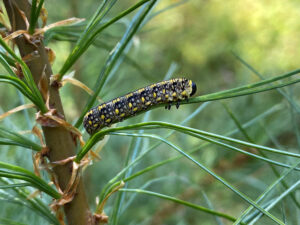By Linda Williams, DNR Forest Health Specialist, Woodruff
Linda.Williams@wisconsin.gov, 920-360-0665

Introduced pine sawfly larva. / Photo Credit: Wisconsin DNR
The introduced pine sawfly was first found in the United States in 1914 and was first detected in Wisconsin in 1944.
Introduced pine sawfly larvae prefer feeding on white pine needles, although literature says they can also feed on jack pine, red pine and scotch pine. Larvae often feed singly, rather than in groups (like redheaded pine sawfly or European pine sawfly do). Larval sawflies can look like caterpillars, but these larvae develop into adult sawflies, which look like a fly or a chunky wasp.
Introduced pine sawfly has two generations each year. Early-season damage is usually minimal, but the second generation of sawflies can feed on new needles as well as older needles, effectively defoliating the trees. Conifers don’t always handle defoliation well, so this defoliation can cause branch dieback, although it only rarely causes whole-tree mortality.
In Wisconsin, populations often remain low enough that noticeable defoliation is not common. As a result, control is usually not necessary. Several parasites, predators including birds and mice, diseases and low winter temperatures can help keep populations of introduced pine sawfly low.
Pesticides can be used to control particularly large infestations, although note that Bacillus thuringiensis var. kurstaki pesticides are specific to caterpillars and will not work on sawfly larvae.
